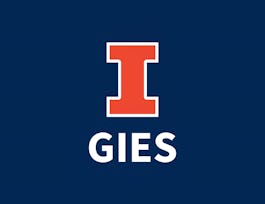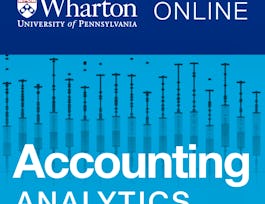Accounting has always been about analytical thinking. From the earliest days of the profession, Luca Pacioli emphasized the importance of math and order for analyzing business transactions. The skillset that accountants have needed to perform math and to keep order has evolved from pencil and paper, to typewriters and calculators, then to spreadsheets and accounting software. A new skillset that is becoming more important for nearly every aspect of business is that of big data analytics: analyzing large amounts of data to find actionable insights. This course is designed to help accounting students develop an analytical mindset and prepare them to use data analytic programming languages like Python and R.



Introduction to Accounting Data Analytics and Visualization
This course is part of Accounting Data Analytics Specialization

Instructor: Ronald Guymon
Sponsored by Syrian Youth Assembly
29,235 already enrolled
(439 reviews)
What you'll learn
Articulate the benefits of using Big Data and analytics in the modern accounting profession.
Describe and implement a framework for using Big data to help provide insights that lead to action.
Critique the ability of a dataset to answer questions, then assemble data from different sources for summarization, visualization, and analysis.
Use Excel, Tableau, and Visual Basic for Applications to design and perform basic and advanced analyses.
Skills you'll gain
Details to know

Add to your LinkedIn profile
1 quiz, 27 assignments
See how employees at top companies are mastering in-demand skills

Build your subject-matter expertise
- Learn new concepts from industry experts
- Gain a foundational understanding of a subject or tool
- Develop job-relevant skills with hands-on projects
- Earn a shareable career certificate


Earn a career certificate
Add this credential to your LinkedIn profile, resume, or CV
Share it on social media and in your performance review

There are 9 modules in this course
In this module, you will become familiar with the course, your instructor and your classmates, and our learning environment. This orientation module will also help you obtain the technical skills required to navigate and be successful in this course.
What's included
2 videos6 readings1 discussion prompt1 plugin
In this module, you will learn how the accounting profession has evolved. You will recognize how data analytics has influenced the accounting profession and how accountants have the ability to impact how data analytics is used in the profession, as well as in an organization. Finally, you will learn how data analytics is influencing the different subdomains within accounting.
What's included
12 videos2 readings1 quiz2 assignments1 discussion prompt
In this module, you will learn to recognize the importance of making room for empirical enquiry in decision making. You will explore characteristics of an analytical mindset in business and accounting contexts, and link those to your core courses. You will then evaluate a framework for making data-driven decisions using big data.
What's included
12 videos2 readings4 assignments
This module looks at specific characteristics of data that make it useful for decision making.
What's included
12 videos2 readings3 assignments
In this module, you will learn fundamental principles that underlie data visualizations. Using those principles, you will identify use cases for different charts and learn how to build those charts in Excel. You will then use your knowledge of different charts to identify alternative charts that are better suited for directing attention.
What's included
17 videos2 readings4 assignments1 peer review
In this module, you’ll learn how to use Tableau to do with data what spies do when observing their surroundings: get an overview of the data, narrow in on certain aspects of the data that seem abnormal, and then analyze the data. Tableau is a great tool for facilitating the overview, zoom, then filter details-on-demand approach. Tableau is a lot like a more powerful version of Excel's pivot table and pivot chart functionality.
What's included
13 videos2 readings3 assignments
In this module, you'll be guided through a mini-case study that will illustrate the first three parts of the FACT model, with a focus on the C, or calculations part of the FACT model. First, you will perform a correlation analysis to identify two-way relationships, and analyze correlations using a correlation matrix and scatter plots. You will then build on your knowledge of correlations and learn how to perform regression analysis in Excel. Finally, you will learn how to interpret and evaluate the diagnostic metrics and plots of a regression analysis.
What's included
13 videos2 readings4 assignments1 peer review
In this module, you’ll learn how the regression algorithm can be applied to fit a wide variety of relationships among data. Specifically, you’ll learn how to set up the data and run a regression to estimate the parameters of nonlinear relationships, categorical independent variables. You’ll also investigate if the effect of an independent variable depends on the level of another independent variable by including interaction terms in the multiple regression model. Another aspect of this module is learning how to evaluate models, regression or otherwise, to find the most favorable levels of the independent variables. For models that explain revenue, the most favorable levels of the independent variables will maximize revenue. In contrast, if you have a model that describes costs, like a budget, then the most favorable levels of the independent variables will minimize costs. Optimizing models can be difficult because there are so many inputs and constraints that need to be managed. In this module, you’ll learn how to use the Solver Add-In to find the optimal level of inputs. For some models, the dependent variable is a binary variable that has only two values, such as true/false, win/lose, or invest/not invest. In these situations, a special type of regression, called logistic regression, is used to predict how each observation should be classified. You’ll learn about the logit transformation that’s used to convert a binary outcome to a linear relationship with the independent variables. Excel doesn’t have a built-in logistic regression tool, so you’ll learn how to manually design a logistic regression model, and then optimize the parameters using the Solver Add-In tool.
What's included
12 videos2 readings3 assignments
The lessons in this module are organized around several useful tasks, including stacking multiple dataframes together into one dataframe, creating multiple histograms to accompany the descriptive statistics, and learning how to perform k-means clustering. After going through this module, you’ll not only gain a foundation to help you understand coding, but you’ll also learn more about analyzing financial data. Along the way, I hope that you’ll also pick up on a few other useful Excel functions.
What's included
14 videos4 readings4 assignments1 plugin
Instructor

Offered by
Why people choose Coursera for their career




Learner reviews
439 reviews
- 5 stars
84.51%
- 4 stars
12.98%
- 3 stars
0.45%
- 2 stars
0.91%
- 1 star
1.13%
Showing 3 of 439
Reviewed on Jul 23, 2024
This course is very helpful in a career with data analytics as it has touched all aspects such as statistics accountancy tableaue Excel and VBA
Reviewed on Jun 2, 2020
The lecturer is very concise and goes through concepts in depth by showing examples that build on top of previous knowledge and used dataset that was previously introduced.
Reviewed on Aug 23, 2020
Excellent course. I loved it from the beginning to the end. Enjoyed throughly the two assignments. Professor teaching skill is increadible
Recommended if you're interested in Business

University of Illinois Urbana-Champaign

Association of International Certified Professional Accountants

University of Illinois Urbana-Champaign

University of Pennsylvania

Open new doors with Coursera Plus
Unlimited access to 10,000+ world-class courses, hands-on projects, and job-ready certificate programs - all included in your subscription
Advance your career with an online degree
Earn a degree from world-class universities - 100% online
Join over 3,400 global companies that choose Coursera for Business
Upskill your employees to excel in the digital economy


